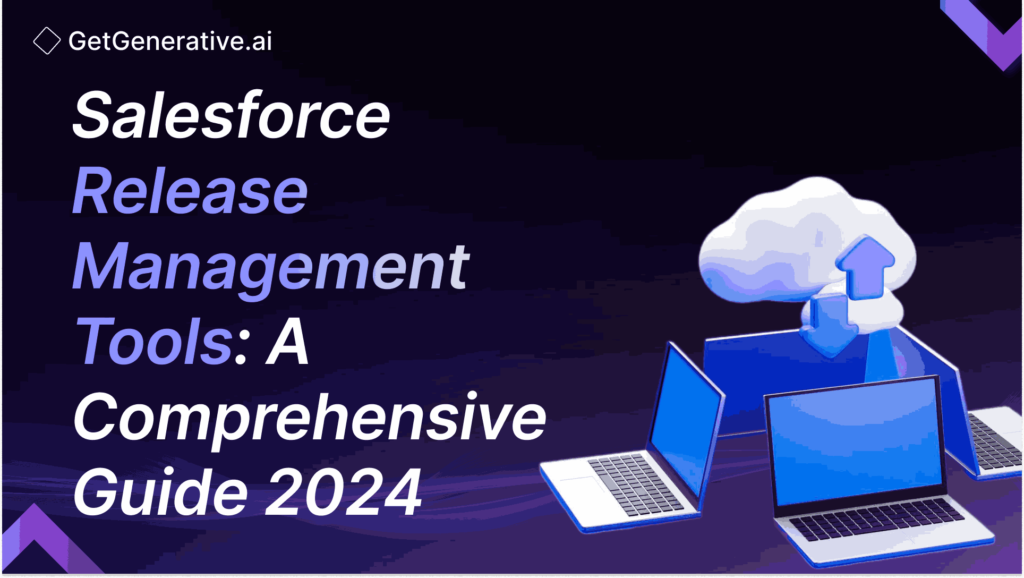Salesforce Release Management Tools: A Comprehensive Guide 2024
In today’s fast-paced business environment, efficient release management is crucial for organizations using Salesforce. According to a recent study by Forrester, companies implementing effective release management practices see a 20% increase in developer productivity and a 30% reduction in deployment-related issues.
As Salesforce continues to dominate the CRM market with a 21.8% market share in 2024, the need for robust release management tools has never been greater.
What is Release Management in Salesforce?
Release management in Salesforce refers to planning, scheduling, and controlling the deployment of new features, updates, and fixes across various Salesforce environments. It encompasses version control, testing, deployment, and monitoring to ensure smooth transitions between development, testing, and production environments.
Salesforce Release Management Tools
Gearset
Gearset is a powerful DevOps solution designed specifically for Salesforce. It offers:
- Automated deployments and rollbacks
- Comprehensive testing and validation
- Change monitoring and alerting
- Data migration tools
Gearset’s intuitive interface and robust feature set make it a popular choice among Salesforce developers and administrators.
Copado
Copado is an end-to-end DevOps platform that provides:
- Continuous integration and delivery (CI/CD) pipelines
- Version control integration
- Automated testing and compliance checks
- Release management and orchestration
Copado’s strength lies in its ability to streamline the entire development lifecycle, from planning to deployment.
AutoRABIT
AutoRABIT offers a comprehensive suite of tools for Salesforce release management, including:
- Version control and CI/CD automation
- Data migration and seeding
- Automated regression testing
- Compliance and security features
AutoRABIT is known for its robust backup and recovery capabilities, making it a solid choice for organizations prioritizing data security.
Related Read – Top Salesforce Tools – You Should Know
Salesforce DevOps Center
Salesforce’s native DevOps Center provides:
- Pipeline and deployment management
- Work item tracking
- Environment management
- Integration with source control systems
As a native Salesforce tool, DevOps Center offers seamless integration with the Salesforce platform, making it an attractive option for teams looking for a native solution.
Prodly
Prodly specializes in data deployment and offers:
- Data migration and seeding
- Relational data deployment
- Sandbox management
- Test data management
Prodly’s focus on data management makes it an excellent complementary tool for organizations dealing with complex data structures and relationships.
How to Automate Salesforce Deployments?
Automating Salesforce deployments is crucial for maintaining efficiency, reducing errors, and ensuring consistent release processes. Here’s a detailed look at how to achieve this:
Implement Version Control:
- Use Git repositories (e.g., GitHub, Bitbucket, GitLab) to store Salesforce metadata.
- Organize your repository with a clear branching strategy (e.g., Gitflow).
- Store all customizations, including Apex classes, Visualforce pages, Lightning components, and configuration metadata.
Set up CI/CD Pipelines:
- Utilize tools like Jenkins, GitLab CI, or Azure DevOps.
- Configure your pipeline to trigger builds on code commits or pull requests.
- Include stages for building, testing, and deploying to different environments.
Create Automated Test Suites:
- Develop comprehensive Apex test classes covering at least 75% of your code (Salesforce requirement).
- Implement integration tests to verify system behavior across multiple components.
- Create UI tests using tools like Selenium or Salesforce’s Lightning Testing Service.
Use Metadata APIs for Deployments:
- Leverage the Salesforce Metadata API for programmatic deployments.
- Use tools like Ant Migration Tool or Salesforce DX CLI to script deployments.
- Implement delta deployments to only push changed components, reducing deployment time.
Implement Post-Deployment Validation:
- Create automated scripts to verify critical functionality post-deployment.
- Use tools like Selenium or Puppeteer for automated UI testing.
- Implement data validation scripts to ensure data integrity.
Also Read – Salesforce Automation Tools: A Comprehensive Guide
Leverage Salesforce DX:
- Adopt Salesforce DX for a more modular, package-based development approach.
- Scratch orgs are used for feature development and testing.
- Implement source tracking to push and pull changes between local environments and orgs easily.
Automate Sandbox Refreshes:
- Use the Salesforce Metadata API or tools like Gearset to automate sandbox creation and refreshes.
- Implement post-refresh scripts to anonymize sensitive data and configure sandboxes for testing.
Implement Feature Toggles:
- Use custom settings or custom metadata types to create feature toggles.
- This allows for easier deployment of partially completed features and A/B testing.
Set Up Monitoring and Alerting:
- Implement logging and monitoring solutions to track deployment success and failures.
- Set up alerts for critical errors or failed deployments.
- Use tools like Salesforce Shield for enhanced security monitoring.
Automate Release Notes Generation:
- Use commit messages or work item descriptions to automatically generate release notes.
- Tools like Release Notes Generator for Salesforce can help automate this process.
Implement Rollback Procedures:
- Develop automated rollback scripts for critical components.
- Use tools like Gearset or Copado that offer one-click rollback features.
Continuous Integration with Salesforce DX:
- Implement continuous integration using Salesforce DX and scratch orgs.
- Automate the creation of scratch orgs, push source, run tests, and delete the org after each build.
By implementing these automation strategies, you can significantly streamline your Salesforce deployment process, reduce manual errors, and increase the frequency and reliability of your releases. Start small, perhaps with a single project or team, and gradually expand your automation efforts across your entire Salesforce ecosystem.
What are the Best Salesforce CI/CD Tools?
While the “best” tool depends on specific organizational needs, some top Salesforce CI/CD tools include:
- Jenkins (with Salesforce plugins)
- GitLab CI/CD
- Azure DevOps
- CircleCI
- Copado Continuous Integration
These tools offer robust pipelines, integrations with version control systems, and automated testing capabilities.
Salesforce Sandbox Management Best Practices
Effective sandbox management is crucial for successful release management. Best practices include:
- Implement a clear sandbox strategy (e.g., Development, Integration, UAT, Training)
- Regularly refresh sandboxes to keep data current
- Use data masking to protect sensitive information
- Implement access controls and governance for sandbox environments
- Automate sandbox creation and refresh processes where possible
How to Ensure Data Integrity in Salesforce Releases?
Maintaining data integrity during releases is critical. Key strategies include:
- Implement comprehensive data validation rules
- Use data loader tools for large-scale data migrations
- Perform thorough testing, including integration and regression tests
- Implement data backup and recovery solutions
- Use data comparison tools to verify data consistency post-deployment
Also Read – Salesforce Data Migration Tools: A Comprehensive Guide
Salesforce Release Management Strategies for Large Enterprises
Large enterprises face unique challenges in Salesforce release management. Effective strategies include:
- Implement a robust governance model
- Adopt a multi-tiered environment strategy
- Standardize release processes across business units
- Leverage advanced testing strategies, including automated and performance testing
- Implement change advisory boards (CABs) for release approvals
- Use release management tools that support enterprise-scale operations
Conclusion
Effective release management is crucial for organizations leveraging Salesforce. By utilizing the right tools and implementing best practices, companies can streamline their development processes, reduce errors, and deliver value to users more quickly and reliably. As the Salesforce ecosystem evolves, staying informed about the latest release management tools and strategies will be key to maintaining a competitive edge.
Enhance your Salesforce consulting with GetGenerative.ai. Effortlessly craft outstanding proposals, enabling you to dedicate more time to providing exceptional client service.
Start today!
Frequently Asked Questions (FAQs)
1. How often should we deploy to production in Salesforce?
The frequency of production deployments depends on your organization’s needs and capabilities. Many companies aim for bi-weekly or monthly releases, while some adopt a continuous deployment model.
2. Can we use GitHub to control the Salesforce version?
Yes, GitHub can be used to control Salesforce versions. Many release management tools integrate with GitHub and other popular version control systems.
3. How do we handle conflicting changes in Salesforce deployments?
Track changes using version control systems, implement proper branching strategies, and use merge conflict resolution features in your chosen release management tool.
4. What’s the difference between change sets and metadata API deployments?
Change sets are a native Salesforce feature for moving metadata between orgs, while metadata API deployments offer flexibility and can be automated more easily.
5. How can we ensure compliance in our Salesforce release process?
Implement automated compliance checks in your CI/CD pipeline, use tools that offer compliance features, and maintain comprehensive documentation of your release processes.




